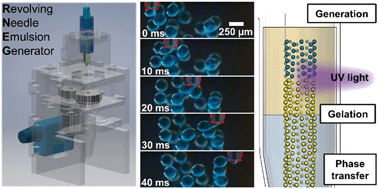Modular off-chip emulsion generator enabled by a revolving needle†
Abstract
Microfluidic chips have demonstrated unparalleled abilities in droplet generation, including precise control over droplet size and monodispersity. And yet, their rather complicated microfabrication process and operation can be a barrier for inexperienced researchers, which hinders microdroplets from unleashing their potential in broader fields of research. Here, we attempt to remove this barrier by developing an integrated and modular revolving needle emulsion generator (RNEG) to achieve high-throughput production of uniformly sized droplets in an off-chip manner. The RNEG works by driving a revolving needle to pinch the dispersed phase in a minicentrifuge tube. The system is constructed using modular components without involving any microfabrication, thereby enabling user-friendly operation. The RNEG is capable of producing microdroplets of various liquids with diameters ranging from tens to hundreds of micrometres. We further examine the principle of operation using numerical simulations and establish a simple model to predict the droplet size. Moreover, by integrating curing and centrifugation processes, the RNEG can produce hydrogel microparticles and transfer them from an oil phase into a water phase. Using this ability, we demonstrate the encapsulation and culture of single yeast cells within hydrogel microparticles. We envisage that the RNEG can become a versatile and powerful tool for high-throughput production of emulsions to facilitate diverse biological and chemical research.

- This article is part of the themed collection: Lab on a Chip Recent HOT Articles


 Please wait while we load your content...
Please wait while we load your content...